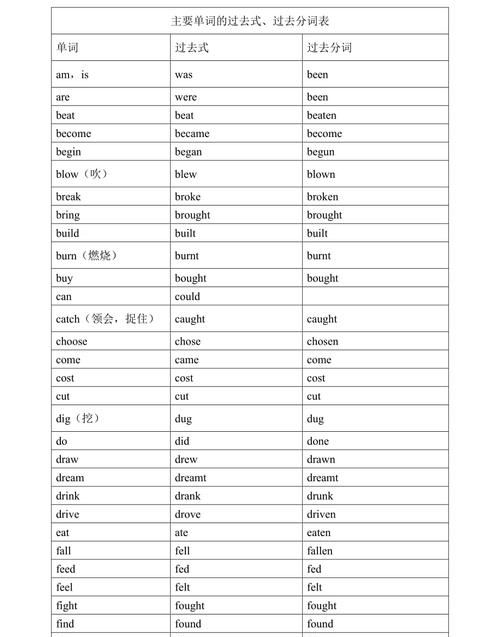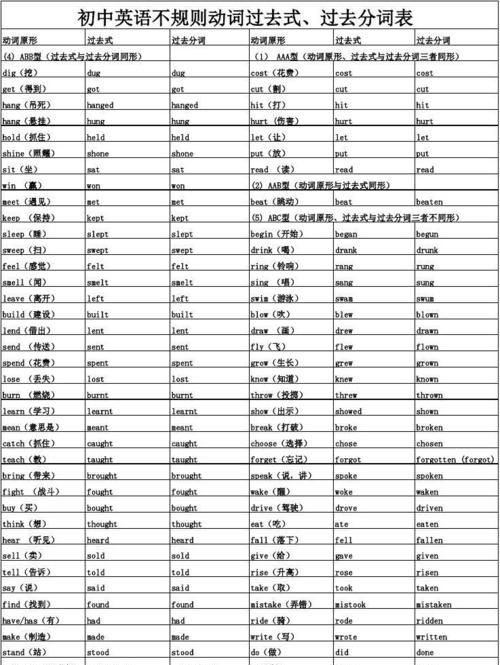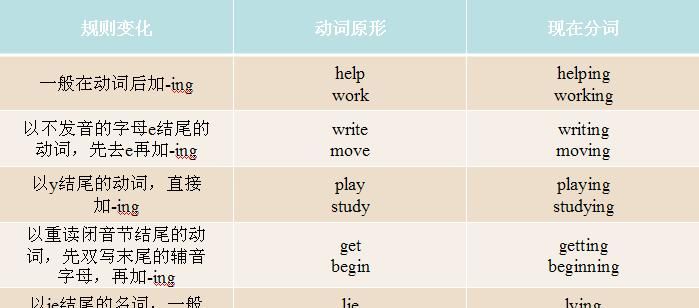本文目录
分词是什么意思
“分词”是具有动词及形容词二者特征的词,尤指以-ing或-ed,-d,-t,-en或-n结尾的英语动词性形容词,具有形容词功能,同时又表现各种动词性特点,如时态、语态、带状语性修饰语的性能及带宾词的性能。
分词分为现在分词和过去分词两种,是一种非谓语动词形式。现在分词和过去分词主要差别在于:现在分词表示“主动和进行”,过去分词表示“被动和完成”(不及物动词的过去分词不表示被动,只表示完成)。分词可以有自己的状语、宾语或逻辑主语等。

分词分类
1、现在分词基本特点
(1)在时间上
表示动作正在进行。例如: a developing country. 一个发展中的国家, boiling water 沸水, rising sun 冉冉升起的太阳。(试比较: a developed country 一个发达国家, boiled water沸水, risen sun升起的太阳)
(2)在语态上
表示主动。例如: the ruling class 统治阶级, the exploiting class 剥削阶级。(试比较: the ruled class 被统治阶级, the exploited class被剥削阶级)
2、过去分词构成规则
(1)一般动词,在词尾直接加“-ed ”。(然而要注意的是,过去分词并不是过去式)
work---worked---worked,visit---visited---visited
(2)以不发音的“e”结尾的动词,只在词尾加“d ”。
live---lived---lived
(3)以“辅音字母 + y ”结尾的动词,将 "y" 变为 "i" ,再加“-ed”。
study—studied—studied,cry—cried—cried,try—tried—tried,fry—fried—fried.
(4)重读闭音节结尾,末尾只有一个辅音字母(r、y、x除外),先双写该辅音字母,再加“-ed”。
以上内容参考 百度百科-分词
英语中什么叫分词
分词就是具有动词及形容词二者特征的词;尤指以-ing或-ed,-d,-t,-en或-n结尾的英语动词性形容词,具有形容词功能,同时又表现各种动词性特点,如时态,语态、带状语性修饰语的性能及带宾词的性能.分词分为现在分词和过去分词两种,是一种非谓语动词形式.现在分词和过去分词主要差别在于:现在分词表示"主动和进行",过去分词表示"被动和完成"(不及物动词的过去分词不表示被动,只表示完成).分词可以有自己的状语、宾语或逻辑主语等.
一.分词总介:
1、 分词作状语
分词在句子中作状语,可以表示时间、条件、原因、结果、让步、伴随等.
分词(短语)作状语时,其逻辑主语应与句中主语相一致..当现在分词表示的动作发生在谓语动词之前时, 则用现在分词的完成式,且所表示动作与谓语动作同时发生, 则用现在分词的一般式.完成或被动关系用过去分词.
(1)现在分词The students went out of the classroom, laughing and talking.
(2)过去分词Accompanied by his friend, he went to the railway station. Given better attention, the plants could grow better.
2、"while ( when, once, until, if , though等连词)+分词"结构
现在分词或过去分词作状语时,有时可以在分词前加while,when, once, although, until, if等连词.
When leaving the airport, she waved again and again to us. While waiting for the train, I had a long talk with my sister about her work……
Once recovered, he threw himself into his work and made every effort to do it well.
Although working very hard, he failed to pass the final exam. If translated word by word, the passage will be difficult to understand.
3、分词作定语
分词作定语时,单个的分词通常放在被修饰的名词之前,分词短语一般置于所修饰的中心词后面.现在分词修饰的是发出该动作的名词(即与名词有主谓关系),过去分词修饰承受该动作的名词(即与名词是动宾关系).
We will go on with our experiment as soon as we get the added fund.
This is really an exhausting day to all of us!
We can see the part of the moon lighted by sunlight.
After a night spent in excitement and sleeplessness, I forced myself to take a long walk along the beach the next day.
More and more developing countries established strategic partnership with developed countries
4、分词作宾语补足语
现在分词在see, watch, hear, observe, notice, feel, find, glimpse, glance等感官动词和look at, listen to等短语动词以及have, keep, get, catch, leave, set, start, send等使役动词后面与名词或代词构成复合宾语,作宾语补语的成分.
5、分词作表语分词作表语通常看作形容词来用.现在分词表示主语的性质,而且主语多为物;过去分词表示主语的感受或状态,主语多为人.
编辑本段
二.现在分词的用法:
1) 做表语:
He was very amused.
That book was rather boring.
很多动词的现在分词都可以作表语:
exciting, interesting, encouraging, disappointing, confusing, touching, puzzling.
2) 作定语:
上面所出现的现在分词都可以用作定语, 修饰一个名词:
That must have been a terrifying experience.
I found him a charming person.
现在分词短语还可以放在名词的后面修饰名词, 相当于一个定语从句:
There are a few boys swimming in the river.
There is a car waiting outside.
3) 作状语:
现在分词短语可以表示一个同时发生的次要的或伴随的动作:
Following Tom, we started to climb the mountain.
Opening the drawer, he took out a box.
Taking a key out of his pocket, he opened the door.
现在分词短语还可以表示原因, 相当于一个原因状语从句:
Not knowing her address, we couldn’t get in touch with her.
Being unemployed, he hasn’t got much money.
现在分词短语还可以表示时间, 相当于一个时间状语从句:
Hearing the news, they all jumped with joy.
Returning home, he began to do his homework.
Jim hurt his arm while playing tennis.
Be careful when crossing the road.
Having found a hotel, we looked for somewhere to have dinner.
Having finished her work, she went home.
4)作宾补:
现在分词在一些动词之后可以做宾语的补语:
例如, see, hear, catch, find, keep , have 等.
I see him passing my house every day.
I caught him stealing things in that shop.
I smelt something burning.
She kept him working all day.
编辑本段
三.过去分词的用法:
1) 作表语:
We were so bored that we couldn’t help yawning.
She felt confused, and even frightened.
They were very pleased with the girl.
I’m satisfied with your answer.
He is not interested in research.
2) 作定语:
She has a pleased look on her face.
The teacher gave us a satisfied smile.
cooked food a written report
fried eggs boiled water
frozen food armed forces
required courses fallen leaves
finished products a forced smile
the risen sun new arrived visitors
What’s the language spoken in that country?
They’re problem left over by history.
The play put on by the teachers was a big success.
Is there anybody injured?
Do you know the number of books ordered?
3)作状语:
Seen from the hill, the city looks magnificent.
Given good health, I hope to finish the work this year.
They came in, followed by some children.
Depressed, he went to see his elder sister.
When treated with kindness, he was very amiable.
4)作宾补:
过去分词也同样可以作宾语的补语, 接在某些动词后面
I will have the clothes washed tomorrow.
When they get back home, they found the room robbed.
希望对你有帮助~~~

英语中分词是什么意思
英语里分词什么意思?
分词分为现在分词和过去分词两种,是一种非谓语动词形式。现在分词和过去分词主要差别在于:现在分词表示“主动和进行”,过去分词表示“被动和完成”(不及物动词的过去分词不表示被动,只表示完成)。分词可以有自己的状语、宾语或逻辑主语等。
简单地说,就是动词的ed形式和ing形式
英语中的现在分词是什么意思
现在分词
现在分词由动词加ing构成。
非谓语动词中的现在分词主要起形容词和副词的作用,在句中作定语、表语、补语或状语。
一、现在分词的两个基本特点。
1. 在时间上表示动作正在进行。例如: a developing country. 一个发展中的国家, boiling water 沸水, rising sun 冉冉升起的太阳。(试比较: a developed country 一个发达国家, boiled water 白开水, risen sun 升起的太阳)
2. 在语态上表示主动。例如: the ruling class 统治阶级, the exploiting class 剥削阶级。(试比较: the ruled class 被统治阶级, the exploited class 被剥削阶级)
二、掌握现在分词的基本功能。
1. 现在分词作定语,表示正在进行的或主动的动作。也可以说明被修饰词的性质和特征,此时可换成相应的定语从句。例如:
① There was a terrible noise following the sudden burst of light.
② He saw a flying bird and raised his bow.
③ I was satisfied with the exciting speech.
2. 现在分词作状语时,可作时间、条件、结果、原因和伴随状语,表示正在进行的或主动的动作。此时分词的逻辑主语就是主句的主语,因此要注意人称、时态和语态的一致性。例如:
① The visiting minister expressed his satisfaction with the talks, adding that he had enjoyed his stay here.
② European football is played in more than 80 countries, making it the most popular sport in the world.
③Seeing from the top of the hill, we can find that the city looks more beautiful.
3. 现在分词作补足语,表示正在进行的或主动的动作。例如:
① Soon they could see the steam rising from the wet clothes.
② The missing boys were last seen playing near the river.
4. 现在分词的独立主格结构作状语。例如:
① With his lips still trembling, he couldn't say a word.
②“ Mama! ” he cried suddenly, tears rolling down his cheeks. “妈妈!”他突然哭着喊,泪水从他的脸上流下来。(这里需要用现在分词的独立主格结构 tears rolling down his cheeks 作状语。)
③ Weather permitting, we'll go to the Great wall. 如果天气允许的话,我们就去长城。(这里需要用现在分词的独立主格结......
英语里什么叫现在分词形式?
就是动词的-ing形式,比如play现在分词是playing

在英语中什么是分词形式
分词是"非谓语动词"的另一种形式,它有两种形式:现在分词(Present Participle)和过去分词(Past Participle)。
要点提示:
初学者在使用分词的时候往往有这样一种困惑--在选用分词去担当句子的某个成分时,不知道是选用它的现在分词形式,还是选用它的过去分词形式。我们认为,要解决好这个问题必须首先要强化两个概念:
1)分词的动作意义是一回事;而分词的形式又是一回事。
2)要分清现在分词与过去分词的区别。因此,在讨论分词的句法作用之前,让我们先讨论一下这两个概念问题。
# 这里所说的"分词的动作意义"是指抛开它的形式,只谈"动作表达的意思"。而"分词的形式"是指现在分词形式与过去分词形式。如:当work作"工作" 的意义用时,无论working还是worked的"动作意义"都是"工作"。 同样,当do作为"做"的意义用时,did和done的"动作意义"都是"做"。这就是说,在决定"分词的形式"之前,先要利用"动作意义"去分析句子的意思,去分析"分词动作"与有关方面的词之间的关系。根据不同的关系再来决定用分词的不同形式。请看下面两个填空题的句子:
A)I heard my brother ( singing , sung ) in the next room .
B)I heard the song ( singing , sung ) in English .
# 要分清现在分词与过去分词的区别。
分清现在分词与过去分词的区别是我们决定用何词形式的重要依据。下面我们看看这两种分词形式的区别:
现在分词:
1)分词和与其相关的名词、代词之间构成 一种"主谓关系",即"主动态"。这里 说的与分词相关的名词、代词要依分词在句中担当成分的不同而不同。如:分词若在句中充当定语,那么被它所修饰的词就是"相关词";要是分词作宾语补足语,那么宾语就是"相关词"; 分词若在句中充当表语或是状语,那么句子的主语就是分词的"相关词"。
2)现在分词表示一个"正在发生的动作"; 或是表示一个"在现在或过去一段时间内经常化的动作"。
过去分词:
1)分词和与其相关的名词、代词之间构成一种"动宾关系",即"被动态"。这里所说的"与分词的相关词"的所指与"现在分词中讲的所指"一样。
2)过去分词表示一个"业已完成的动作"或是表示一个"在以前某个未知时间发生的动作"。
现在我们用实例来说明分词的这两大区别。
例一
I don't like canned food , I prefer something fresh .
我不喜欢吃罐装食品,我爱吃新鲜的。
The story is very much interesting .
这个故事非常有趣。
She is interested in music . 她对音乐很感兴趣。
Hearing Xiong Ni win the first place finally , we all jumped with joy .
听到熊倪最后获得了第一名,我们都高兴得跳起来了。
Hurt by their impolite words , he flared up .
由于他们那些不礼貌的话伤害了他,他突然发火了。
Mother heard her kid opening the door . 妈妈听见她的孩子在开门。
Mother heard the door opened . 妈妈听见门打开了。
例二
China belongs to developing countries .
中国属于发展中国家。
China has no time to lose to catch up with the developed countries in the world .
中国要分秒必争地赶上世界的发达国家。
He saw a man in uniform coming towards him .
他看见一位穿制服的人朝他走过来。
The window is broken .
这窗户是破的。
The man delivering mails to my office every day is a retired worker .
给我办公室送邮件的人是位退休工人.
Our president is a man loved by all .
我们的总裁是一位受人爱戴的人。
经过上面的分析,我们再来讨论分词在句子中的作用就比较容易了。分词在句子里1)作定语,2)作表语,3)作状语,4)作宾语补足语。
1)作定语
单个分词作定语,分词一般说来写在被修饰的名词、代词之前;分词短语作定语时,分词放在被修饰词之后。
现在分词作定语,主要说明"正在进行的动作"或是"一个在现在或过去某段时间内的经常化动作" 。
过去分词作定语,主要说明"业已完成的动作"或是"一个在以前某个未知时间发生的动作" 。如果与上述两点不符,就不能用分词作定语,而要改用定语从句作定语。下面我们来具体看看分词作定语的情况:
That is an interesting TV theater .那是一部非常有趣的电视剧。
They reduced the number of animals used in experiments.
他们减少了用于试验的动物数量。
The girl standing by her mother looked very timid.
站在她妈妈旁边的那个女孩看上去很胆小。
The letter reaching me today is from my family. (错误)
The letter that reached me is from my family. (正确)
我今天收到的那封信是我家里寄来的。
另外,分词作定语还有"being + 过去分词"的形式。这种表达形式的意义是"分词动作正在进行;但分词动作与其所修饰的词之间是动宾关系" 。例如:
The cloverleaf intersection being built is designed by a young man .
那座正在兴建的立交桥是一位年轻人设计的。
The topics being discussed everywhere recently is concerned about the Olympics 2000 .最近到处在议论的话题都与两千年奥运会有关。
2)作表语
现在分词作表语主要是表示主语的性质、特征;而过去分词作表语则多表示主语所处的状态。例如:
The news is really exciting .那消息真让人兴奋。
He got very much excited when he heard that Fu Mingxia won the 26th gold medal for China .当他听到伏明霞为中国获得第26块金牌时,他非常激动。
The food smells inviting .这道菜香味怡人。
She looked disappointed after she lost the game.
输掉那场比赛后,她看上去很失望。
What he said sounds convincing. 他的话听起来很有说服力。
The shop was closed when she got there .她到那儿时,那家商店关门了。
3) 作状语
分词,无论是现在分词还是过去分词,作状语时,往往说明这样几种情况:
-- 分词表示的动作总是句子主语发出的动作之一;也就是说句子的主语或是在逻辑上是分词动作的执行者,这时,主语和分词动作构成的是"主谓关系",是"主动态";或是在形式上是分词动作的主语,在这种情况下,主语和分词动作构成的是"动宾关系",是"被动态"。总之,分词的主语必须与句子的主语一致,或是同一个人或是同一件事。从另一方面看,我们可以说--分词作状语时,如果主语和分词动作构成的是"主谓关系",我们用现在分词;如果主语和分词动作构成的是"动宾关系",我们就用过去分词。
-- 分词动作与谓语动作基本上在前后差不多的世间发生,或是同时发生。
-- 在句子中,对谓语动作而言,分词动作要相对次要一些。也就是说,我们总是选一个最重要的动作为句子的谓语,而把其它的次要动作写成分词形式。
上述的情况也可视为使用分词作状语的前提条件。
由于分词有两种形式,所以分词作状语的意义和作用也不尽相同:现在分词作状语主要是对谓语动作加以修饰、烘托;过去分词作状语主要是说明谓语动作发生的背景、条件。分词作状语,常用来说明谓动作发生的原因、方式、时间、条件、结果等方面的情况。例如:
Not knowing his phone number, I wrote him a letter .
(表示原因)由于不知道他的电话号码,我给他写了一封信。
Choked by the heavy smoke , he could hardly breathe .
(表示原因)他被浓烟呛了,几乎不能呼吸了。
When leaving the airport , Yang Xia and Din Meiyuan waved with tears to the Chinese delegates left in Sydney.
(表示时间)当杨霞和丁美媛离开机场时,他们含而泪向留在悉尼的中国奥运代表们挥手告别。
Seen from the top of the hill, the city looks significant .
(表示时间)从山顶看这座城市时,它看起来很壮丽。
Laughing and talking loudly, the audience left the stadium after the match.
(表示伴随性的方式)比赛结束后,观众们大声说着,笑着离开了赛场。
Surrounded by his students , the professor sat there cheerfully .
(表示伴随性的方式)那位教授在学生们的簇拥下,兴高采烈地坐在那儿。
Considering the poorer financial status, they decided to delay their project .
(表示条件)鉴于较差的经济状况,他们决定将工程推迟。
Given better attention, the accident could have been avoided.
(表示条件)要是多加注意,那次事故就可以避免了。
分词作时间或条件状语时,为了明确其意义有时可在分词前加上when , while , if 等连词。例如:
Please take notes while listening to the report .听报告时请作好笔记。
When explaining it to her , you should be patient .
对她解释这件事时,你应该耐心些。
If merely drawn on your imagination , the report will not be convincing .
假若仅靠你的想象去写,报告是不会有说服力的。
另外,若想明确表示分词动作发生在谓语动作之前,可用分词的完成形式(其中包括主动式和被动式):
--"Having + 过去分词"(主动式),
--"Having + been + 过去分词"(被动式)。
--分词作状语还有"being + 过去分词"的形式。
这种表达形式的意义是"分词动作正在进行;但分词动作与句子的主语之间是动宾关系" 。
这种形式与单纯的过去分词或过去分词短语作状语不相同之处是:它不仅说明了分词动作与句子的主语之间是动宾关系;而且还强调了分词动作正在进行。例如:
Having been discussed several times , the decision was finally made .
进行了几次讨论之后,终于作出了决定。
Being surrounded by a large crowd of his fans , Jordan could hardly move a step further.
乔丹被他的一大群球迷簇拥着,他几乎无法挪动一步。
当句子的主语既不是分词的逻辑主语也不是它的形式主语时,也就是说这时主语和分词之间没有关系,分词可以带上自己的逻辑主语而构成独立结构(Absolute Construction)。独立结构在形式和作用上都与分词作状语的情况相似,但它不算作句子成分。例如:
The game being over, the audience stood up and cheered for the winner.
(表示时间)比赛结束时,观众站起来为胜者欢呼。
The decision having been made, they began to think of how to carry it out .
(表示时间)决议已经作出,他们开始考虑怎样执行它。
4) 作宾语补足语和主语补足语
分词作宾语补足语和主语补足语其实是同一成分用于两种不同的句式中。具体地说,主动态句子中的宾语补足语就是被动态句子中的主语补足语。分词作宾语补足语时,如果分词与宾语构成"主谓关系",用现在分词;如果构成"动宾关系",则用过去分词。常用分词作宾语补足语的动词有:find , feel , get , have , hear , keep , notice , see , watch等。例如:
When I passed by his office , I found John reading something carefully .
(宾语补足语)我经过约瀚的办公室时,发现他正在认真地看什么文件。
I heard my sister singing that song in English outside.
(宾语补足语)我听到妹妹在外面用英文唱那首歌。
My sister was heard singing that song in English outside.
(主语补足语)有人听到我妹妹在外面用英文唱那首歌。
They once heard the song sung in English.
(宾语补足语)他们曾听见有人用英文唱那首歌。
The song was once heard sung in English.
(主语补足语)有人曾听见那首歌被人用英文唱过。
另外,"being + 过去分词"的形式也能用作"宾语补足语"。 这种表达形式的意义是"分词动作正在进行;但分词动作与宾语之间是动宾关系"。例如:
When we came near his garden, we found his house being painted .
当我们走近他的花园时,发现他的房子正在做油漆。
They heard the topic being discussed all over the community.
他们听到那个话题在社区上下为人们谈论着。
She noticed the new wall being scratched by her litter son.
她发现那面新墙正被她的小儿子画得乱七八糟。
在复合宾语结构中,有些动词如:feel , hear , notice see , watch等后面既可以用现在分词作宾语补足语,也可用不带to的不定式来充当。但这两种情况在表达的意义上有所不相同:用现在分词作宾语补足语,强调分词动作在发生和进行之中;用不带to的不定式来充当宾语补足语,则着重说明不定式动作从发生到结束的全过程。因此,说话人可根据需要和可能来确定自己的选择。例如:
I saw him crossing the street 我看见他正在过街。
I saw him cross the street 我看见他过街去了。
They heard him reading something aloud in the next room.
他们听见他在隔壁房间朗读。
They heard him read something aloud in the next room for a while.
他们听见他在隔壁房间朗读了一会儿。

以上就是关于英语中什么叫分词形式,分词是什么意思的全部内容,以及英语中什么叫分词形式 的相关内容,希望能够帮到您。

